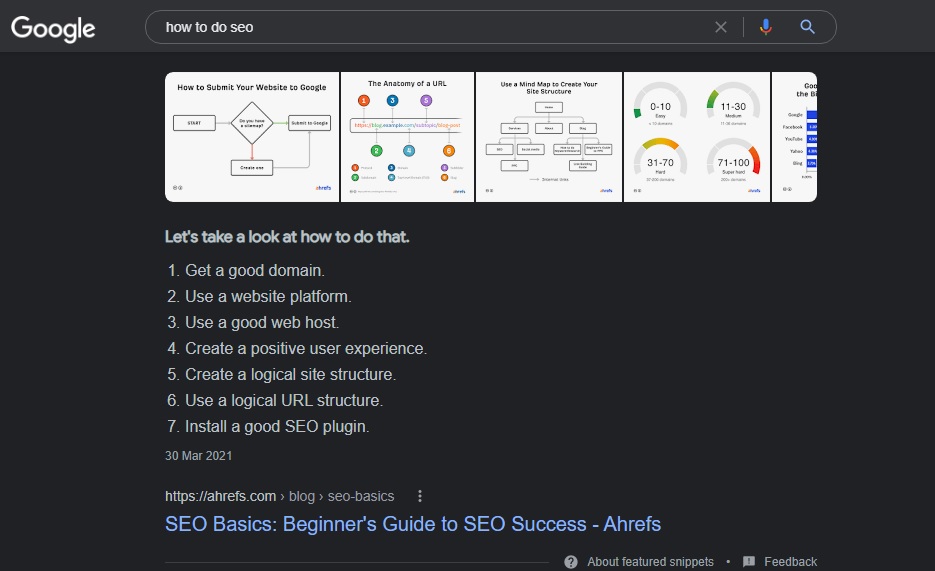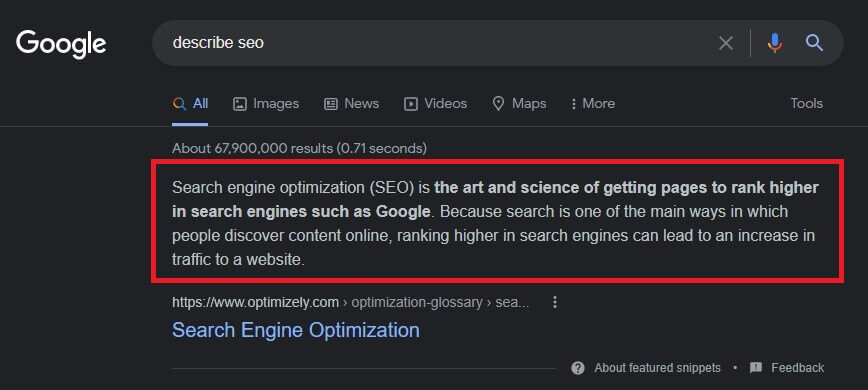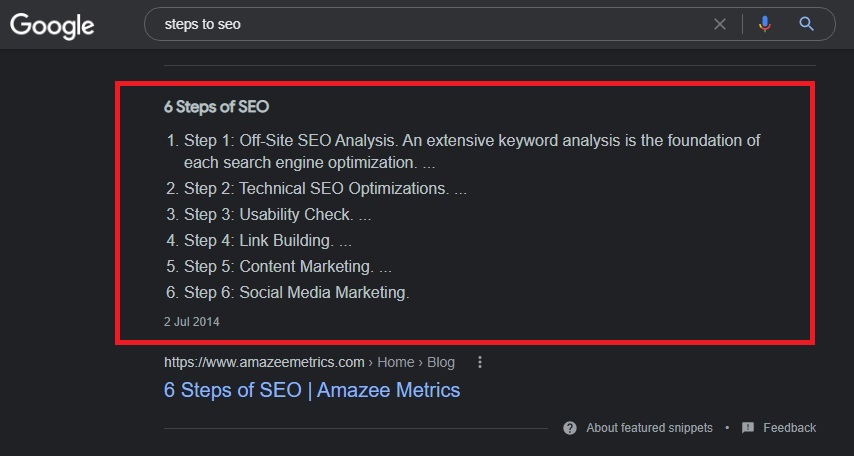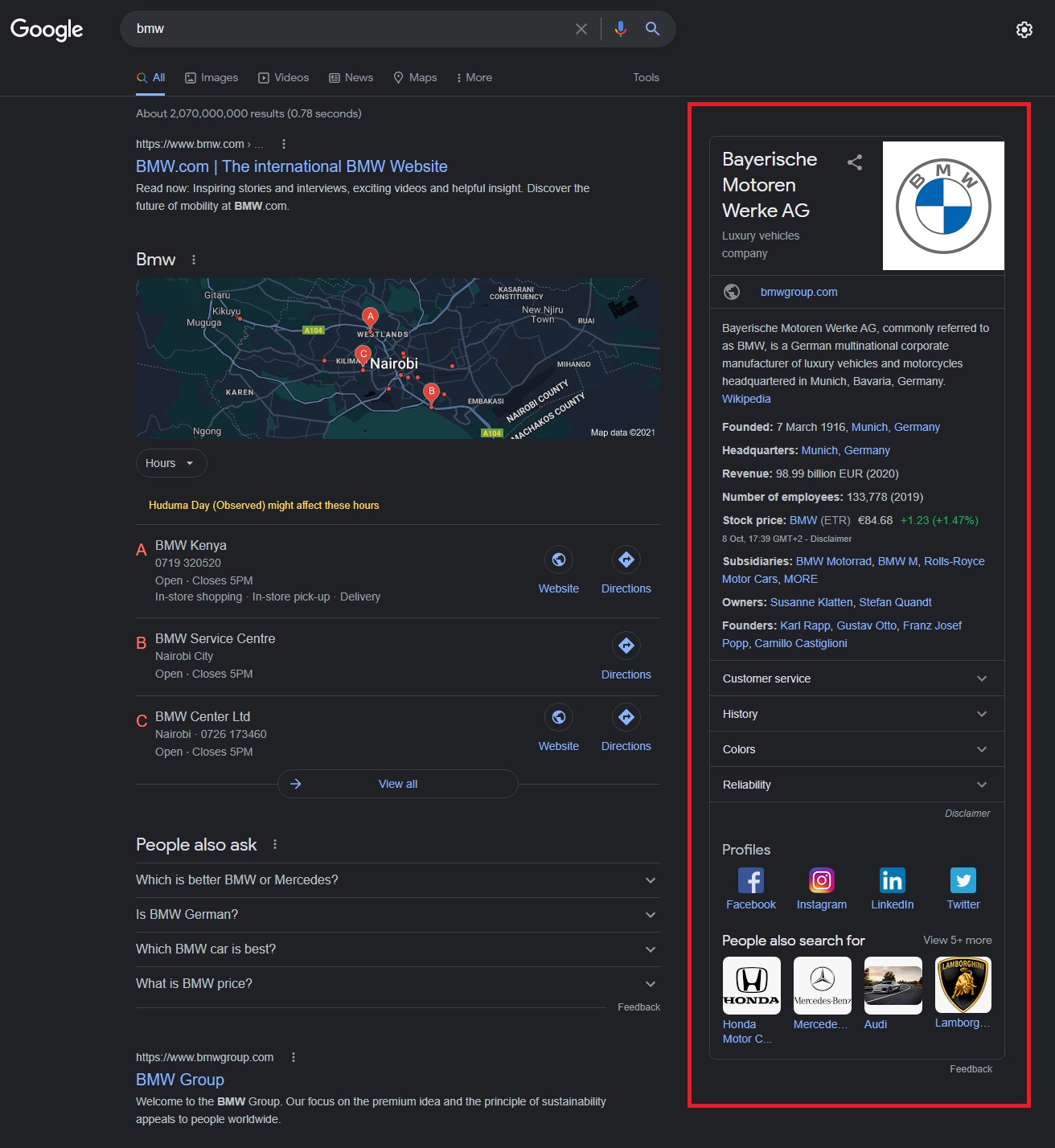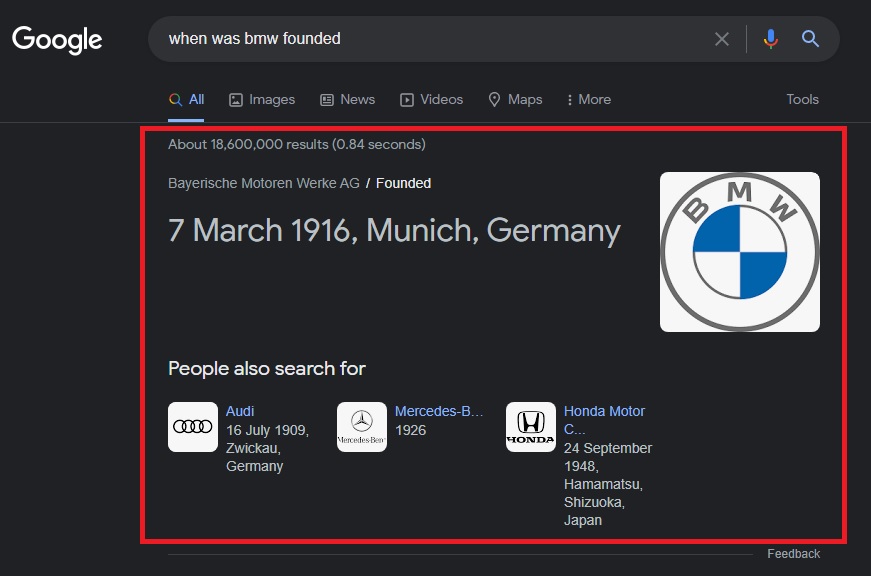Did you know that you can get to the top of Google Search Engine Results Pages (SERPs) without using backlinks or doing major updates to your content?
Yes, you can through the use of featured snippets.
When you conduct a search on Google, there are some small pieces of information shown at the top of the SERPs, which provide answers to the question that you typed in. These are the featured snippets.
You may be wondering what benefit you stand to derive from having your website content featured in the snippets, right?
If they see your answer in the snippet, will they be incentivized to visit your website or blog?
Well, let’s take a look at a small example.
If you typed out “How to do SEO” on Google, you would get a snippet with a bunch of answers as shown below:
This featured snippet shows 7 quick answers, but if you are familiar with SEO, you know that those are not the full answers when you want to do SEO.
There are many more, and the person asking the question would have to click through to the website and read more.
Featured snippets are changing all the time, and this one example does not cover all there is to know about them.
In this article, you will know about:
- The types of featured snippets that you can use
- How featured snippets will affect your SEO ranking
- How to search for and optimize the snippets that you already own
- How to rank better for featured snippets
- How to track the performance of your featured snippets
Let us begin
The types of featured snippets that you can use
You must get to know the types of snippets that are used on Google, and also the types of queries that bring about the snippets, so you know which ones you want to own. The different snippets are:
- Paragraph snippets
- Numbered lists
- Bullet lists
- Table snippets
- Video snippets
In keeping with our example above, let us look at the different featured snippets that you can get from asking questions about Search Engine Optimization, SEO.
Paragraph Snippets
This is a snippet that shows an answer in the form of a paragraph, almost similar to what you see on a Metadescription, but with a lot more information.
Question: Describe SEO
Numbered List
This is in the form of a numbered list of steps to take to answer the questions being asked.
Question: steps to SEO
Bullet List
This is a bulleted list of answers.
Question: top SEO tools.
Table
The answers are given in the form of a table.
Question: Google most searched (looking for the most searched terms on Google)
Video
This is a video usually taken from YouTube, but can sometimes be taken from a website.
Question: SEO video tutorial.
These are the main snippets that you will find when questions are asked on Google.
However, in order to avoid confusion, you need to be aware of knowledge panels, which look like snippets but do not give much information, based on the questions being asked.
Knowledge Panel
Knowledge Card
Knowledge Entity Carousel
The knowledge answers are pulled from the knowledge graph. They do not pull answers from one of the top-ranking search engine results but several sources.
Although they may have a link to the information source, the ink cannot be clicked as you would find in featured snippets.
This should help you avoid confusion.
How featured snippets will affect your SEO ranking
In the year 2014, Google introduced featured snippets and one can say that they are one of the most important SERP changes that Google has made in more than a decade.
There are quite a number of ranking issues that were changed when the featured snippets were introduced, both for SEO professionals and Internet users.
- A quick way to get to the top-ranking position
- Sometimes fewer clicks – the downside
- Featured snippets being used as branding opportunities
- Featured snippets being used to remove duplication on SERPS
- The ability to opt-out of featured snippets – which you should not do under any circumstances.
A quick way to get to the top-ranking position
If you have content that is ranking high on the SERPs for a question that is being asked by a user on Google, and you have optimized it to appear in a featured snippet, then you can get a quick way of getting to the top position.
Now that sounds confusing, right?
Let us break it down some more and clear the confusion.
Featured snippets, according to some studies, are derived from the top 10 ranking sources on Google. Most of them, especially short snippets, come from the top 5.
This means that the higher your content ranks on Google the higher the chances are for it to get placed in a featured snippet
Getting to the first position on the SERPs is difficult when relying on a ranking keyword.
However, if a keyword does trigger a featured snippet, then your content can easily get to the top position if you had optimized for featured snippets.
Sometimes fewer clicks – the downside
There is a downside to featured snippets, in that they can sometimes lead to fewer clicks.
If the question being asked on Google requires a short answer, the answer will be displayed in the snippet, and the user does not need to click through to the website.
This can happen for search queries, but not for all of them. It is a tricky situation, so let us take a look at one of these questions and see what happens.
Let us imagine that a user wants to know when the NASDAQ closes, he or she will type in, “When does NASDAQ close”.
The answer is right there. The NASDAQ closes at 4:00 p.m. ET. The snippet goes ahead and even shows that it opens at 9.30 a.m. ET.
This kind of featured snippet reduces the number of clicks to the website Investopedia since the answer is right there. There is no need to click through to the website.
Now let’s look at another scenario, where the user wants to know how NASDAQ works.
Question: How does NASDAQ work?
Although the featured snippet gives an overview answer to the question, it is not enough and the user will click through and read more about how NASDAQ works.
This featured snippet will increase the click-through rate.
To avoid this type of reduced clicks, you should always optimize for keywords that have a high Click Per Search rate. This is something that you should be aware of when using keyword research tools when looking to optimize for featured snippets.
Today, Google is testing the use of featured snippets and “People Also Ask” boxes to give answers to queries.
You should just take a note of this and make sure that you optimize for queries as you are optimizing for featured snippets.
Featured snippets being used as branding opportunities
Apart from getting clicks when your content is on featured snippets, users will also get to see your brand as the first thing on the SERPs.
When people ask questions on mobile devices, the featured snippets are very dominant on the page and scream for attention.
This is why you should optimize your content for featured snippets, given that most people are browsing the internet using their mobile devices.
Building your brand is one of the best ways to have long-term growth of your business, and the featured snippets are a great way of doing this.
The more that your brand is featured when asking for relevant answers, the more your business is associated with leadership within your niche. This leads to trust and long-term success.
Featured snippets being used to remove duplication on SERPs
According to research, owning a featured snippet when they were first introduced, always resulted in more clicks.
Today, Google has introduced what is called featured snippet deduplication
Way back when the featured snippets started appearing on Google, the owner of the snippet would also be listed in the Standard results, within the first page of the SERP.
Today, that is no longer the case.
Once your page has appeared in the featured snippets section, then it will not appear in the standard results below.
The deduplication process has resulted in a drop in traffic, for websites that own featured snippets, but it does not fully kill the traffic flow.
The ability to opt out of featured snippets – which you should not do under any circumstances.
After the deduplication of results for people who own feature snippets, people started experimenting with opting out of the featured snippets.
Those who tried it found that opting out actually led to a reduction in traffic.
Google offers several ways in which you can opt out of featured snippets. However, some of the methods you can use can block your content from appearing within the standard results of the SERPs.
When you use some of the methods allowed by Google to opt out of featured snippets, Google can only then use your Metadescription and hard-coded title tags, which can lead to reduced traffic.
The best way to opt out of the featured snippets is to have a max-snipper robot meta tag on your website.
This code defines the highest number of characters that Google can show in the text of their featured snippets.
The featured snippets are longer than the Metadescription on the standard results, so you can set the maximum length of the text used. This can be up to 170 characters.
Add the following code to the <head> section of the web page that you want to be excluded from featured snippets.
<meta name=”robots” content=”max-snippet:170″ />
Google says that this code will not mean that your content MUST be removed from the featured snippets. It only restricts the amount of text that can be added to a snippet.
If you want to completely remove the page from the featured snippets then you must use the data-nosnippet HTML attribute or the nosnippet robot meta tag.
TIP:
If you are considering opting out of the featured snippets, first check on the position that your page will rank for the keywords, without owning the featured snippet.
The best way to do this is to append “&num=9” to your URL when in incognito mode on the browser and see how you would rank without a featured snippet.
If your rank goes lower, then you should not opt out of the featured snippet.
How to search for and optimize the snippets that you already own
You cannot use the Google search console when looking for information regarding optimizing for featured snippets.
You may have to use another keywords research tool such as Ahrefs Site Explorer.
Go to Site Explorer and then add the URL of your website. Now move to the Organic Keywords and you will see the keywords that you rank for.
Now you can go ahead and filter these keywords where Google does show a featured snippet with your content on it.
There are times when Google will fail to get everything wrong, despite being a smart tool. This means that you must also check the search queries on Google to ensure that it is pulling your content for the keywords that you have identified in Ahrefs.
You should note that there is a higher chance of getting in the featured snipes when you use long-tail keywords.
When you check on the keywords using Ahrefs, you might find that there are hundreds of featured snippets where your content ranks for inclusion.
This is too much for you to manually check, right?
This is where you get down and create a list of the most important featured snippets for your website.
The best way to start doing this is to look at the search volume.
If you filter the results by looking for search volume above 500, your results will be whittled down quite a lot and you may end up with 20 to 30 search queries.
This is a number that you can manually check, right?
When you do this manually, you can play around with the filters, and see how you rank by location and industry.
Certain queries will lead to erroneous information and you should be on the lookout for these too.
For example, if you asked the question about the most visited websites in the United States, you may get a lot of useless results such as craigslist.
So, when you are manually manipulating your search queries to see where you get added to featured snippets, play around with the way you label your website during optimization so you do not end up in useless featured snippets.
There are many situations where you might think that polishing the featured snippet may get you better traffic results, but you should avoid this as it could make things worse.
It is better to be in an imperfect featured snippet than to lose the position to a competitor when you think you are polishing your content for the snippet.
How to rank better for featured snippets
You can increase the volume of organic traffic coming to your site using featured snippets.
Let us look at a couple of ways in which you can do this.
Leverage content that you own and is already ranking high in the SERPs
If you already have pages that are ranking within the top 10 results for a particular search term, and you are not appearing in a featured snippet, you can make a few tweaks on your page to own a featured snippet.
How do you go about this?
Well, it is not as difficult as you might think.
Use the Site Explorer and then filter the keywords that kickstart featured snippers where you rank for positions 2 to 10.
Why should you search for positions 2 to 10 and not 1 to10?
Well, ever since deduplication was started on Google, featured snippets were categorized as one of the top 10 positions, and not just a feature on top of the standard search results.
This means that the first position is usually taken up by featured snippets.
When you search for positions 2 to 10, then you remove the results where you rank first due to a featured snippet.
This means that you will be looking for opportunities that will allow you to steal a featured snippet from your competition, where they rank 2nd and below.
This is an SEO heist that will enable your website to get more traffic.
First, start by prioritizing the keywords that you want to target in your heist. You cannot manage to stela thousands of featured snippets, but when you customize the keywords, you will get a manageable number.
You should start by checking on keywords based on the search volume, and you should also avoid going for long-tail keywords at this point.
Remember that the probability of you owning a featured snippet increases tremendously when you have a prominent organic rank for that search query.
The filters that you use will be different in each scenario. However, if you are not ranking high in any of the keywords that you are targeting, then you must get back to creating great content and building links.
After you have got your list, how should you proceed?
Well, you should now go and manually check the keywords as mentioned before and see which ones have a solid business value.
Search queries such as “Most popular websites” will have a lower business value than “How to get quality backlinks”. The first query has a much higher search volume, but in the second one, you will get people who want to build quality backlinks as your customers and not just idlers checking on which websites are popular.
When you out in the search query, you will see the kind of featured snippets that Google prefers.
Then check your content and see if you have an answer that can be better ranked than those seen in the snippets.
For example, if Google has used a featured snippet pulled from a table of contents made by your competitor, then you can try and create a table of contents on your site, with regards to the keywords.
TIP: Having a table of contents with relevant keywords can get you into featured snippets quite easily.
Apart from adding the keywords in your table of content, make sure that the content on the page is relevant.
Some people have a table of content on the page, and the article is made of a bunch of links to other pages on their website. This will not favor well on featured snippets. Make sure that your article is true to the table of contents that you create.
Create new content that is targeted to appear on featured snippets
You can create content that is targeted at appearing in featured snippets. This means targeting keywords that are relevant to your business and have a high demand.
If the content you create ends up in a featured snippet, then that is just a great bonus, right?
This means that you should start creating new content targeted at featured snippets from this moment onwards.
For instance, you could have an SEO blog and want to create an article about how to perform SEO in 2021 and beyond.
You can apply the same filters that you used in the Site Explorer in the Keyword Explorer of Ahrefs, and find the featured snippets that you can potentially appear in.
Simply enter the keyword “Perform SEO 2021” and then go to the “Also rank for” report and apply the featured snippet filter.
You will be presented with keywords that the top-ranked pages for “Perform SEO 2021” also rank for, and also trigger the featured snipes.
All you have to do is include some of the subtopics in the report within the guide you write for your post, and you may be able to rank for the same featured snippets.
The only issue might be the fact that there will be very many keywords in this query.
You just cannot include them in your article.
Therefore, look for the relevant keywords, which have a great monthly search volume, and which you feel you can easily rank for.
This means adding a few more filters such as:
- Keyword Difficulty (KD): Less than30
- Minimum Monthly Search Volume: 100
- Keyword Includes: “Perform SEO”
- Keyword Doesn’t Include: Tools – You might find that there are a lot of “SEO Tools” keywords that trigger featured snippets.
After including these filters, the number of relevant keywords that are easy to rank for, and which will trigger a featured snippet is greatly reduced.
Now you simply have to manually look at the list of subtopics that you can add to your article contextually to enable your content to appear in a featured snippet.
You might find several keywords that you may never have thought of using, such as “Voice search for native languages”, which may help you get into featured snippets because many others don’t use it too.
If you do find a keyword that has a lot of competition and would be difficult to win a snippet, it does not mean that you should avoid it.
Simply add it to your article content, since it is still relevant to your potential readers.
A step-by-step guide to optimizing your content for featured snippets.
Now that you know what you should do in order to win featured snippets, let us take you through each of the steps in a practical manner.
#1: Perform proper keyword research and target keywords that are used in a question format
You cannot avoid keyword research if you want to create content that will rank high on the SERPs, and the same can be said for featured snippets.
You must look at answering questions that your target customers and audience are asking on the search engines.
There are several keyword research tools that you can use.
The KWFinder is a great tool and all you have to do is type in the seed keyword and then click on the “Questions” tab.
#2: Make good use of the “People Also Ask” section
Researching keywords is a great way of finding out what people are asking about within your niche, but do not forget to check the “People Also Ask” section of the SERPs.
There are usually a lot of insights that you can get from browsing this section.
Note that when you click on one question, a bunch of other related questions appear.
This is a treasure trove as it offers you a lot of opportunities to expand a topic that you aim to answer in your article.
Answering as many possible questions that appear in this section can improve your chances of winning a featured snippet.
#3: Work hard to appear on the first page of the SERPs
Remember that only those who appear on the first pages of the SERPs get the opportunity to win a featured snippet.
This means that you must optimize your website to appear on the first page – you must continue doing SEO on your pages regularly.
Make sure that you check on your traditional SEO practices, such as:
- Check on any penalties that your website may have suffered and then address them by correcting errors and faults
- Make your website or blog easy to crawl or navigate
- Perform a lot of internal linking and make sure your external links lead to quality websites.
- Ensure your website loads quickly and is optimized for mobile browsing
- Make sure that you are using the SSL protocol
- Use URLs that are easy to remember
- Make sure that your content is targeted at search intent, and then keep it fresh
- Make sure your images are optimized
- Make your age user-friendly and readable.
#4: Use the Inverted or Inverse Pyramid to write your content
The Inverted or Inverse Pyramid is a technique used in journalism where information is structured in a certain way.
You start by answering the pertinent questions, and then go ahead and provide information that supports the answer in the rest of your content.
It looks like this:
- Most Newsworthy Information (Who, What, When, Where, How, why)
- Important details
- Other general or background information
According to studies, the inverted pyramid is one of the best ways in which you can win a featured snippet.
#5: Use words that will trigger a featured snippet
This is something that will genuinely excite you.
Certain words usually trigger a featured snippet and many people are not aware that they do.
The studies are based on words, used in common themes that trigger featured snippets more often.
The words are:
| General Questions | Transition | Time | Status |
| do | forming | deadline | be |
| does | become | often | is |
| cause | becoming | years | another |
| causes | removing | last | was |
| define | closing | when | as |
| definition | develop | age | are |
| mean | improve | ||
| meaning | getting | ||
| creating | |||
| made |
The same studies went ahead and came up with a list of words that are LEAST LIKELY to trigger a featured snippet. These are the words that you should try to avoid.
The words are:
| Information or Help | Subjective Queries |
| source | free |
| diagram | comparison |
| template | rankings |
| course | review |
| programs | reviews |
| forms | best |
| courses | good |
| templates | |
| guide | |
| sample | |
| tutorial |
#6: Make sure that you format your article well
As we have shown earlier, snippets come in various forms. You must structure your content according to the featured snippets that you are targeting.
So, if you want to win a table featured snippet, then make sure that your answers to the questions you target are placed in a table format.
If you want to target a list snippet, then make sure that your content is put in a well-structured list and has proper headings.
When you are formatting content to appear in the featured snippets list, here are some things that you should pay attention to:
- Use header tags such as H1, H2, H3, etc., and also write descriptive headers.
- Make sure that you use punchy and short answers to the questions you are targeting.
- Use numbered lists, tables, bullet points, and graphs in your content.
- Add relevant images with the snippet question that you are targeting
#7: Use the optimal word count
A recent study by SEMrush, made a very useful discovery when it came to featured snippets.
After analyzing 10 million keywords and a million domains, they found out that – a high number of featured snipes used a total of 40 to 50words in answering target queries.
Another study by HubSpot talks about 58 words as the most optimal.
This is why you must be brief when you are answering the target queries and make sure that you use direct and straightforward language.
#8: Add a Question-and-Answer section or FAQ in your content
Websites that offer products and services for sale benefit a lot from having a FAQs section.
These are answers to some of the questions that their target customers would have about their products and services.
When you create such a section, then these answers will most probably crop up in a featured snippet when triggered by one of the questions that you have answered.
When you create a FAQs section, you are showing your readers and also the search engine that you are in touch with the concerns of your target audience.
You are willing to give answers, and this fits in well with Google’s E-A-T principles.
If you are operating in a niche that does not need a FAQs section, methods number 1 to 7 should help you win a featured snippet.
How to track the performance of your featured snippets
Getting your web page to be in the featured snippet section can be equated to ranking first for a particular keyword.
If you are tracking your website for keyword-based ranking positions, then you should also track your ranking for featured snippets.
This is where you can use the Ahrefs Rank Tracker to your benefit.
Start by adding queries where you already have a featured snippet.
The way you can use Ahrefs to find these is by following this path on the tool:
Site Explorer -> Enter domain -> Organic keywords -> SERP Features -> Featured snippets -> Only linking to target.
Once you have the results, export them as a CSV.
Copy all the keywords in the CSV and then paste them into the Rank Tracker.
Rank Tracker -> select project -> Add keywords
Now go ahead and add any of the keywords that are appearing in featured snippets that you want to appear in.
You should tag them with a few words such as “featured snippets”, which will make it much easier for you when you want to filter them in the future. Do this before you add them to the Rank Tracker.
Now click on “Add Keywords” at the bottom of the page and you will be able to see when you win or lose a featured snippet.
This is the way you will go about checking on this:
Rank Tracker -> select project -> Overview -> filter for the snippets you’re tracking with the “tag” filter -> click “SERP features” tab -> select “Featured snippet”
The results that you get will differ from time to time, and it would be best if you do this check every week or two.
You should remember that the SERPs are very fluid today, and you must keep checking on your ranking in order to keep a high rank consistently.
There are certain parts of the reports that you should keep an eye on, and these are:
- The number of snippets that you own, and the positive or negative changes that happen within a certain period
- The total number of featured snipes for the keywords that you are tracking and any positive or negative changes that occur in a certain period.
- The percentage of the queries which trigger a featured snippet that you won. For instance, if there are 200tracked keywords that trigger featured snippets and you own 10%, then this means that you have 20 featured snippets for that keyword.
- The graph that shows your progress over a long time.
In order for you to go deeper into the specifics about the keywords, you should scroll down the keywords in the reports, and see the time comparison data.
In order to isolate the cases where you are getting the upper hand, there are two more filters that you should apply:
- Position: Improved – you will get results showing you cases where you now rank higher as opposed to the previous period
- SERP features: This shows that you rank for the featured snippet.
Always keep scrolling down to see who is the winner of the featured snippet for the time period that you are tracking.
In order to see the cases where you have lost a featured snippet, simply do a reverse filter as shown below:
- Position: declined – this will show you the snippets that have declined and those that you do not own.
However, this will not show you if you have lost a snippet but will show all the snippets that have declined in the chosen period.
In Conclusion
Getting into the first position within the Google Search Engine Results Pages is not the only way in which you can improve the volume of traffic coming to your website or blog.
Getting ranked on featured snippets is another way in which you can do this.
Let’s look at the main takeaways of the article above:
- Perform your keyword research and target keywords that are typed in question format.
- Make sure that you check the “People Also Ask” section to get more questions to target.
- Aim to appear on the first page of the SERPs in order to get access to featured snippets
- Always use the inverted pyramid when you are writing your content.
- Make sure that you use words that can trigger a featured snippet
- Format your articles in a manner that is favored by your target featured snippet
- Make sure you stick to 49 to 80 words when writing answers for featured snippets
- The flow and structure of your article should be excellent.
- Add a FAQ or Q&A section on your blog or website.
That is how you can get your website on a featured snippet and increase traffic to your blog or website.
Use the comments section below to tell us how your website performs after you have used the tips and tricks in this article to win featured snippets.


